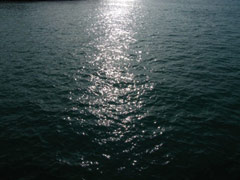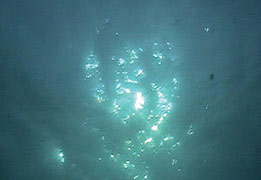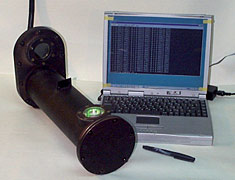Ocean optics and underwater imaging.
The hydrooptical topics were inherited by the IAP RAS from the RRI where an underwater laser observation system was first created as early as in the 1960s under the guidance of A. V. Gaponov-Grekhov.
|
|
Surface manifestations of an internal wave, recorded by an optical meter
of the two-dimensional spatial wave spectrum
(based on the field experimental data)
|
|
This system was employed in the pioneering experiments on detection and imaging of underwater objects. At the same time, D. M. Bravo-Zhivotovsky, L. S. Dolin, A. G. Luchinin, and V. A. Saveliev obtained fundamental results basic to the modern theory of instrumental imaging in turbid media. Namely, the interrelation between the coherence theory and the energy (radiance) description of a light field was stated, the small-angle approximation of the radiative transfer equation was developed; and on this basis, the analytical models for the structural evolution of a laser beam transmitted through a medium with strongly anisotropic scattering were constructed, the regularities of the turbid medium effect on modulated (by a high-frequency signal) light beams were determined, and analytical methods for calculating the characteristics of an underwater object image with allowance for the effects of absorption and multiple scattering of light in water were elaborated, which enabled one to estimate the potential capabilities of underwater imaging systems (including the laser ones) and to determine the requirements to their technical parameters.
The experience gained in these studies was effectively used at the IAP RAS for the development of optical diagnostic techniques of the upper ocean, including the theory of laser detection and imaging of underwater objects from aircrafts. As a result of an extensive series of theoretical and experimental studies, L. S. Dolin, A. G. Luchinin, and their team have developed models for laser pulse backscattering in the aqueous medium, proposed a lidar method for measuring the water absorption coefficient, which was then tested in marine missions, and demonstrated the possibilities of lidar recording of the IW and ocean fronts.
Studies of the mechanisms of water surface image formation resulted in the development of a remote optical method for measuring the spectrum-energy characteristics of wind waves (A. G. Luchinin, V. I. Titov, and E. M. Zuikova) and in the creation of a shipborne complex of devices capable of real-time recording of the wave spectrum variability. This complex together with the radar facilities is successfully used in numerous marine missions to explore the mechanisms of the wind wave variability caused by IW, inhomogeneous flows, SAS films, and other physical factors.
Lidar methods of ocean sounding.
Of considerable interest is also the theory of stochastization of light fields and optical images affected by the randomly inhomogeneous air — water interface, developed at the IAP RAS (A. G. Luchinin and V. L. Weber). Analytical models for fluctuations of underwater irradiance and a lidar signal coming from the water depth sounded from an aircraft carrier, as well as methods for calculating random realizations and statistical characteristics of images of the sea bottom or an underwater object observed through the rough sea surface were elaborated. An original technique for the numerical simulation of "instantaneous" and "accumulated" images was developed on this basis and the possibilities of increasing the bottom imaging depth under daylight conditions due to optimizing the observation process were revealed.
A new method for the correction of refraction distortions in lidar images of the sea bottom observed through a rough sea bottom is proposed and theoretically studied. The angle of the laser beam refraction by the randomly inhomogeneous air — water interface can be determined by the angular distribution center of the radiance of a signal scattered by water; a multi-element photodetector or at least three photodetectors with special directional diagrams can be used for this purpose. Equations for average statistical estimation of this angle and for the estimate variance are obtained. It is shown that control of the beam refraction angle by this method significantly improves the modulation transfer function of the laser imaging system
(L. S. Dolin and A. G. Luchinin).
A new method for lidar sounding of the ocean is proposed and substantiated, which permits remote measuring of the modulation transfer function (MTF) of water layers; it is required for predicting the operating range of the optical facilities of underwater imaging and for the correction of the image distortions caused by light scattering in water. The MTF of a water layer of a given thickness can be determined by an image of the light spot that appears on the lower boundary of the layer at the time of the laser pulse passage through it. An algorithm for the MTF retrieval from this image is given. Specific lidar schemes for MTF measurements are proposed (L. S. Dolin).
|
Examples of optical images when viewed through the sea surface: through the flat water — air interface (left); at a wind speed of 5 m/s (center); a retrieved image (right). The frame size is 2 × 2 m, the object depth
is 10 m, and the resolution element is 2 cm
|
An analytical model for a lidar image of the IW pycnocline is developed. It is shown that a lidar image of IW is the superposition of two images, i.e. the reflection and shadow (transmission) ones. The first image shows perturbations of the profile of the light backscattering coefficient in the IW field, while the second one maps perturbations of the optical depth of the water layer, in which the IW violated the horizontal uniformity of the optical characteristics. Algorithms for the IW field retrieval from these images are proposed. As distinct from the reflection image, the shadow one is not sensitive to fine details of the hydrooptical characteristic profiles and can be used for determining the IW parameters using very rough data on the optical properties of water. The possibility of determining the mode composition, the length, and the amplitude of IW modes by their lidar images up to a depth of about 40 m is shown by an example of the Barents Sea and involving real simultaneously measured profiles of
the water density and of the attenuation coefficient of the light beam (L. S. Dolin, I. S Dolina, and
V. A. Saveliev).
 |
Example of simulating the isolines of the spatial distribution of the light attenuation coefficient in the two-mode IW field (left) and of the relief of the function 10 log P(x, z) (right);
P(x, z) is the power of the lidar echo-signal (in W) coming from the depth z for a given position of the vessel
(coordinate x)
|
Adaptive methods for imaging through a rough sea surface under daylight illumination.
Physical grounds for the adaptive method of imaging the sea bottom and underwater objects through a rough sea surface are developed to decrease the image distortions caused by the refraction of light at the water — air interface (refraction distortions). The idea of the new imaging method is to instantaneously record the bottom image (in the blue-green part of the spectrum) and the wave image on the sea surface (in the red part of the spectrum) and to eliminate refraction distortions using information on the relief of the sea surface contained in its image. Algorithms for correction of the images distorted by waves are developed and tested, and their high efficiency was confirmed by laboratory experiments (L. S. Dolin, A. G. Luchinin,
D. G. Turlaev, and V. I. Titov).
Underwater sun track as a source of information on wind waves.
The possibilities of wind wave diagnostics by means of underwater imaging facilities have been studied for the first time at the IAP RAS. Models for random realization and statistical characteristics of an image of the rough sea surface observed from under the water under day-light illumination were developed. Processing of images of the sun track formed as a result of the direct sun-light refraction allows determining not only the slope variances and the curvature of the surface, but also the coefficients of spatial and temporal correlations of its slopes and thus the short-wave part of the wind wave spectrum. Algorithms for finding the mentioned characteristics of the underwater sun track are obtained and tested using numerical and field experimental data. Therefore, a methodic base for the employment of bottom optical detectors as a means of surface wave control in shallow water was provided (L. S. Dolin and A. A. Molkov).
 |
 |
Surface (above) and underwater (below)
sun tracks
|
Besides the remote facilities, contact instruments for hydrooptical measurements, i.e., submerged devices enabling one to obtain primary data on optical characteristics of water, are developed at the IAP RAS. These devices are needed to control the remote measuring accuracy and provide ecological monitoring of natural water basins.
 |
TURBIDO device for measuring the sea water scattering coefficient at three wavelengths (475, 525, and 590 nm)
in a wide value range (0.05—3 m—1)
|





